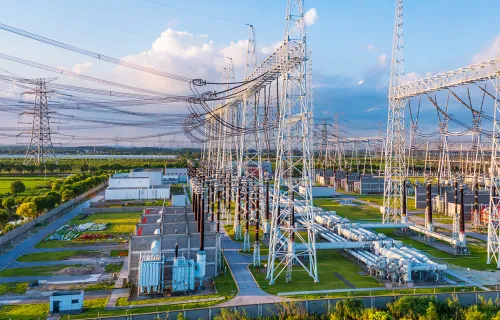There is no lack of data in energy and utilities. The challenge is knowing where the data is, getting it quickly, making sure it's accurate and using it to drive decisions.
Several factors are driving greater demand for data in the industry, including consumer expectations, cost-effective technology and decades of investment in data collection. According to Diane Gutiw, this creates a “perfect storm for data and analytics to be the future” of the industry.
Digital consumers expect their power providers to personalize their services and offer options for smarter, greener and lower-cost energy. The cloud is another data accelerator, because it makes it easier and quicker to pull information together and present it to different stakeholders. These drivers shape and normalize stakeholders’ expectations for data that they can easily access, quickly understand and readily trust to inform their decisions and actions.
Traditionally, data and the tools used to extract it belonged to IT. Now, business analysts and leaders are taking more ownership of data because of its business value. Energy and utility organizations are making several changes as a result. For example, they are spinning off new departments, branches and expertise (e.g., power users) focused on digitization and analytics, whereas IT now provides more of a stabilization platform and support.
Instilling trust in data requires data governance as a practice across the entire organization. As data ownership moves from IT to business, the business also needs to govern it. “At the end of the day, everybody needs to understand where the data is coming from, what the quality is and what decisions can be relied upon,” says Paul Kulpas. They need to know when the data is “gold-plated,” when it is less solid but usable for directional analysis and when it's just not ready for primetime.
Gutiw comments, “As we pull in more organizational data, we are shifting to pull it with a purpose.” This means focusing on getting quick return on investment and answering key questions iteratively, and then incrementally, to grow the data platform to get an enterprise view. For example, data from IoT and meters is vast. “But, if you have a use case or a question that relies on that data, you can pull it in a purposeful way,” says Gutiw. She adds that some architecture components in a data lake allow organizations to bring in unstructured data and then decide what data to promote into a data warehouse or a semantic business context layer.
Another trend is that “good enough” data is a great place to start, rather than waiting for the data to be perfect. Using an analytics platform early on with “good enough” data allows organizations to understand the quality of the information and how to normalize it. For example, if a utility collects IoT data at different time intervals, they can determine how to normalize it in a way that is meaningful.
Peter Warren shares, “One of my favorite sayings is, ‘If you make it perfect, sometimes it's perfectly late.’ As an example: Understanding which smart meters report in every night, so when somebody calls in and says, ‘My power's out,’ the power company knows if that smart meter is reliable. Therefore, they can enable the call center agent to ask a few more questions. This saved a million dollars (CAD) per year for one client by preventing unnecessary truck roll.”
Gutiw suggests a key issue for data governance transformation is, “How do you manage this data platform as a product?” In agile analytics, there is product ownership. The source system or use case has a product owner, but the overall platform also needs ownership.
Kulpas observes that, “particularly in the utility sector, there are strong silos. There's generation, there's transmission, and there isn't a lot of conversation between the two. When we can start to break down those silos and share data across them, that's when the new insights start to emerge.”
Gutiw shares examples of how data helps energy companies and utilities improve worker safety. “If we look at some of the provinces [in Canada] with extreme weather, knowing where teams are in real-time, deploying teams in a way that [ensures] the right person is going to the right place.” Asking the question, “Can anything be done virtually?” is an important practice that can help uncover ways of collecting data from different assets remotely, in areas where it is dangerous to send someone up a pole, for example. Being able to leverage drones or satellite data to get the information and collect it digitally helps avoid sending a human into a situation that might not be safe due to temperature or logistics.
Managing resource constraints as baby boomers retire is another area where data is helping determine ways to do things smarter and allow automation and remote data collection to support workers. “We've spent quite a bit of time with prairie and remote operations and trying to see how can we help those folks get better real-time data and get it in a way that's more automated,” Gutiw explains.
From reducing operational costs to improving health and safety to better serving customers, energy and utilities organizations are achieving quick and actionable insights from leaning on their data. Of course, there is still work to be done. As Gutiw points out, citizen demand for data-driven decision-making will be “a real driver across all industries in moving toward better ways of managing our data.” And, when it comes to data governance, the analytics is not the end of the journey, Kulpas reminds us: “there is so much opportunity to create valuable data products within the organization, while satisfying your analytics needs.”
- 1. Introduction
-
Peter Warren:
Hello, everyone, and welcome back to our series on energy and utilities and what's driving change in our industry. Today, I'm joined by two of my great colleagues, Diane and Paul. Starting with Diane, why don't you introduce yourself?
Diane Gutiw:
Great. Thanks, Peter. My name is Diane Gutiw, and I'm the Vice-President in Canada of Analytics and AI, with a special focus lately on utilities.
Peter Warren:
Great. And Paul?
Paul Kulpas:
Hi, Peter. My name's Paul Kulpas. I'm an Analytics Architect in Diane's analytics practice focused on cloud analytics in the (Microsoft) Azure platform.
- 2. Key factors driving the demand for data today
-
Peter Warren:
Very good, thank you. And as you can probably guess from our guests today, we're going to be talking about data analytics and how it affects energy and utility companies. This is an area that's been very interesting. Everybody will know in this industry that there's no lack of data. The big problem is understanding where that data is, getting it in a timely fashion, making sure it's accurate, and then using it to drive decisions. This is all part of becoming a digital-driven business. Opening it up to both of you, Diane and Paul, you can figure out who wants to answer first. What do you see as the main things driving data and the stakeholders in the different groups? How do you see this going forward?
Diane Gutiw:
Great, so I can take that one, Peter. I think there are a number of things that are really driving the use of data, the obvious one being our 45, 50 years of investment in operational systems and data storage. But a few things have come together that have really driven the demand for data. One is that our citizens are super savvy now. You can open up your phone app. You've got smart devices. And the last two years, we've all sat and watched the news as we've used data in the pandemic to drive decisions.
So, the expectation is that information is available and organizations are customizing services, personalizing services, and providing options for cost savings, energy savings, conservation, and smart use of energy. And a lot of organizations are providing this in digital apps to let customers and citizens use that information for their best purposes.
Another thing that's really brought it together is the move to cloud architectures, cloud data, because it's making it easier and quicker to be able to pull information together and present it to different data stakeholders - whether it's customers or internal people, data scientists. So, the combination of the citizens being ready, the technology being at a point where it really is cost effective and easier to pull it together, and then the investment that we've all made in collecting data, has just made it a perfect storm for data and analytics to be the future.
- 3. Data ownership is shifting from IT to business
-
Peter Warren:
That's perfect. And what do you see? It's interesting you mentioned the lines of business in IT. Do you see the lines blurring between who's getting the data and who's using the data, or how that's working out?
Diane Gutiw:
Yeah, I'd say there's a real tug-of-war going on, which is a bit fun for us to watch. Traditionally, data warehousing and APIs (application programming interfaces), ETLs (extract, transform load), the tools we used to pull data, belonged to IT. What we're seeing is that the use of information is more driven by business and executives. So, we're pulling the data, and all of the processes that go with it, closer to the business. And a lot of organizations, specifically in utilities, are spinning off new departments, branches, expertise that are focused on digitization and analytics and pulling it out of IT, where IT is becoming more of a stabilization platform support tool. But, the data itself belongs to the business, which is where it should be in order for it to be leveraged for business purposes.
Peter Warren:
I can tell you a bit of a story. I was doing a meeting with a client a little while ago, and we were talking about Environmental, Social and Governance (ESG) and the need for data for that. And it was actually interesting. This particular client is on their digital journey. I would say that they're not exactly connected at the business and IT level as much as you just indicated. It was interesting to see that I actually had to explain what ESG was to the IT department, even though they have all the data that the business needs to prove this. There was a disconnect. Do you see that in other situations, where there's a disconnect between maybe even out to the IoT data and AMI data, and so on?
Diane Gutiw:
Yeah, I'll take it, and then maybe Paul will want to add a more technical lens. We really are seeing different layers of data stakeholders, and the way that we work with data has changed from loading years and years of operational data, transforming it and storing it in a relational EDW (enterprise data warehouse), which can take months to perform, to be able to support the different types of data stakeholders. So, one would be the data scientists and savvy data analysts that want access to closer to raw, closer to real-time data to find insights.
- 4. Good governance is needed to build trust in data
-
Diane Gutiw:
I think the real key is self-serve. Regardless of who you are, if you're a data scientist, you don't want to have to make 10 requests to different business data system owners to get the data. If you're a business analyst, you don't want to have to pull things together in Excel. And, the real shift, I think, is for executives and management to be able to, as I say, follow that data story and not just rely on static PDFs and graphs and charts, but actually start to see cause-and-effect and have a very easy-to-interpret interface to be able to do that. That's the real shift, and that's the shift that all the technology platforms are moving towards, and cloud is just making it faster and faster to be able to do that and get some decent performance.
Peter Warren:
That's interesting. I think this points to a couple of the things that we often see as limitations for digital adoption - a lack of trust of either the data, a cultural maybe propensity not to actually be organized in a way to use the data. So as people want to become data-driven, I think that having this trust that you're referencing, and the ability to get the data, is going to be a major factor for them to actually then take action on it. Do you see that as one of the factors when you're dealing with your clients?
Paul Kulpas:
Yeah, absolutely. I think trust just speaks to the importance of data governance as a practice across a whole organization. For a long time, as Diane mentioned, analytics was seen as an IT function, and so ownership of the data was the responsibility of IT somehow. Now, we're really coming to understand that the value of the data is value to the business. And so the business needs to own that and to govern it because if they don't trust the numbers, they're not going to rely on the analytics.
So, how do we encourage the leaders in the business to begin to take on that ownership responsibility and be stewards of their own data, and to make sure that they're supported in that journey? Because that can be quite a daunting task at times. But the value of that is, at the end of the day, everybody understands where the data is coming from, where the quality of the data is, what decisions could be relied upon, where the data is gold-plated and is relatively understood, where the data's still a little maybe softer, but can still be used for analysis purposes or directional analysis, and then where you absolutely don't want to go look at that data yet, because it's just not ready for primetime.
- 5. Moving toward purpose-driven data and starting with “good enough”
-
Peter Warren:
What sort of insights do you see people getting as they're starting to gain this trust in the data, that it's moving forward? As you mentioned, some of it might be used softer, some of it may be harder, but there've been well-established things with smart meters and IoT devices with assets and so on. So what sort of things do you see people going, “Ah, I didn't realize that now I've got a better viewpoint?”
Diane Gutiw:
I think as we pull in more organizational data, one of the real shifts is the way in which we pull it in, and it's with a purpose. So we're not loading the entire organization's data into the cloud in one massive swoop. We're really focused on getting that quick return on investment. So loading it by initiative, business question or use case, so that you start to get the answers to your questions very quickly and iteratively, incrementally grow your data platform, so you get that enterprise lens. Some of that data you talked about ─ IoT data, AMI data, streaming IoT ̶ the data is huge, and if you try to stream it all, you're going to have data overload. You're just not even going to know where to begin. But if you have a use case or a question that relies on that data, you bring it in in a purposeful way.
Some of the architecture components that are in place now with a data lake, where you can bring in that unstructured data so it's accessible and available, and then decide which of that data you're going to promote into a data warehouse or a semantic business context layer, you can decide based on what the question is that you're trying to use that data to answer. To Paul's point, knowing what the quality of the data is, putting it together in a way that is meaningful, is really what's going to drive the change. And by doing it by use case, you're being able to do that.
Another thing we're seeing is “good enough” data is a great place to start, rather than waiting for another 10 years for the data to be perfect. Your data likely will never be perfect, but by using an analytics platform early on with “good enough” data, you can start to use that to inform what the quality of information is. How do I have to normalize the information, like your IoT data may be collected at different time intervals? How can I normalize that, so I'm using it in a way that it means something? And then also build continuous improvement for your data quality, monitor being able to point back to the data source and resolve things, so over time that data's going to get even more valuable.
Peter Warren:
I agree with you on that, and we've seen that in other examples. In the oil and gas industry, we've built these models and the utilities model, particularly in the UK, that we've now adopted here in North America, making the data available. I guess the old method was to go hassle the old hardware systems and change the old ERP system to give you the new data. Now, you're actually going directly to the data source and validating it. You're no longer requiring a new report out of a system that takes six months to build. And, I see that as one of the main advantages of moving to the cloud. Would you say that this is a bit of a cultural shift for people, or are they adopting that quickly?
Paul Kulpas:
No, absolutely. It's a shift. The idea that up until now, we've been very focused on source systems and thinking about what data's in what source system. And if I want to answer this question, I go to that data source. And if I want to answer that question, I've got to go over here. The idea that we can start to now bring that data out into our data lake and then begin the process of modeling it there - lightly at first, and then maybe with more intentionality as the business question evolves - we're starting to create new objects that are integrated across sources and do not exist anywhere else. The business value of that has been a real eye-opener for a lot of our clients.
- 6. Moving away from the “old guard” to manage data platforms as products
-
Peter Warren:
It's an interesting one because you're springing things out to the light of day and then applying them for different purposes. I think culturally some organizations, too, have this situation where, and you mentioned organizing new groups for data, there's maybe the legacy group that says, “This is my data, let's say, in my asset system or in my ERP.” But, as people do the energy transition, maybe go into hydrogen, or even as you've also talked a little bit about the human factor, into health and safety and into other areas, this data is being applied for new purposes. There's still, I guess, this data ownership, and then there's this new application for it. So how do you see the old guard working with the new guard, or do you see that an issue?
Diane Gutiw:
I think it's a part of that data governance transformation of how are you going to manage this data platform as a product. A lot of what we do is agile analytics. We have product ownership. So you might have the source system or the use case having a product owner, but the overall platform needs to have ownership, and it can help inform. It's an interesting governance model, because in utilities and the energy industry, there're so many different source systems that are used to manage different parts of the operation. And pulling those together into a joint governance group really requires some coordination, which is why data governance is so critical to making sure ... it's really the foundation … to make sure that this incremental build-out of organizational enterprise-level data is well-managed.
So, I think you really have to coordinate to understand what is the data source, what is the purpose of that data source in that larger enterprise lens, and then how do we manage that, along with new entities that may come out of it. The real value, then, is that you might have concepts that come from multiple data sources that become new, and you stop having the risk of running two different reports from two different systems and get a different number. Simple things like headcount. Am I looking at FTEs? Am I looking at bodies? Am I including contractors? If you can create those pre-canned objects or pre-canned queries, then the folks that are building out your reporting are going to be all using that same joint entity is an example of how we can make that easier, which is really what it's about. We hear over and over again: “This is a great idea, but don't make it harder.”
Paul Kulpas:
Just to add to that, I think we've also got a lot of experience with clients where, particularly in the utility sector, there are quite often quite strong silos. There's generation, there's transmission, and there isn't a lot of conversation between the two. And, if we can start to break down those silos and share data across, that's when the new insights start to emerge.
- 7. Improving health and safety and resource constraints using data insights
-
Peter Warren:
I agree with that, and I think our industry is very focused in on health and safety. There's a bit of a trend to say we've always done it this way, so we'll always do it that way, because this way it keeps it from catching fire, blowing up or hurting people. But, I think that you've also been able to find that some of these insights actually can improve health and safety and training and things. Do you have any examples on that?
Diane Gutiw:
Yeah. If we look at some of the provinces (in Canada) with extreme weather, knowing where teams are in real-time, deploying teams in a way that you're making sure the right person is going to the right place. And, anything that you can do virtually or remotely (which, really, organizations have had to do that during COVID). Being able to leverage that in the future, all the way to collecting data from different assets that were dangerous to send someone up a pole. Being able to leverage drones or satellite data so that you can get the information, you can collect it digitally and avoid sending a human in a situation that maybe isn't safe, depending on weather or temperature, or just because of the logistics of getting that information.
The way we collect data is changing, and the robustness and the quality of that information -if you collect it digitally, real-time - also becomes better, rather than relying on someone having to enter it later if there's somewhere without connectivity. So all of those things, we've looked at the human factor in optimizing resource allocation and how people travel.
The other area in which we're all suffering is baby boomers are retiring, causing resource-capacity constraints. So, again, how can organizations do things smarter, which also lines up with safety. If there's a way that we can do it smarter, lean on humans a little bit less or put humans in a place where we're best suited at working, and allow automation and collection of information remotely to take place to support that. Those are some of the use cases we look at; really looking at the human factor, and we've spent quite a bit of time with prairie and remote operations and trying to see how can we help those folks get better real-time data and get it in a way that's more automated.
- 8. Key takeaways
-
Peter Warren:
That sounds really great. As we wrap this up, any final thoughts that you'd like to leave people with? If you had to give them one or two things to think about when they go back to the office on the day after listening to this, anything that comes to mind?
Diane Gutiw:
Yeah, I think one of the real takeaways is that there is just such a strong citizen demand for data-driven decision-making, and allowing them to have insights into information that's going to save time and cost and money and all of those things, I think, is really critical. And that's going to be a real driver across all industries in moving towards better ways of managing our data. I think waiting too long to jump on board or worrying about the cost effectiveness, there is such a quick ROI for being able to leverage information and make some real cost-saving and time-saving investments that now is the time that the demand is there. And waiting for good enough data or “I'm going to wait and see what the next thing that comes out” isn't necessary, because there's such a strong roadmap for being able to drive this forward now, and lots of great use cases where organizations are getting a real, quick benefit from leaning on their data. I don't know, Paul is anything you want to add to that?
Paul Kulpas:
Yeah. I think maybe just we have this notion that the analytics are downstream of the operational systems. And with the data governance lens, we discover that, actually, it's a continuum where the data capture is just as important as the data analysis, and we can see that end-to-end stream, and that the analytics isn't the end of the journey. The datasets that we are creating and preparing here, there is an audience for that, who wants to take that and take it further. The data science communities, data sharing with partners and internally, there is so much opportunity to create valuable data products within the organization, while satisfying your analytics needs.
Peter Warren:
I like that. I like that whole thing there. One of my favorite sayings is, “If you make it perfect, sometimes it's perfectly late.” And, I think good enough moving forward. We're in an industry where there's caution again about things, the types of stuff we deal with, but again, understanding as you mentioned early, the quantitative value of that data. Is this gold-plated? I like those words. Or is this something that we've had to estimate, gives people a sense of moving forward. And, we've seen examples of reducing major operational costs and understanding smart meter data, understanding which meters report in every night. And they say, I'm here so that when somebody calls in and says, "My power's out," we have an understanding of whether their smart meter is one that we can trust. If it says it's off, is it really off? And therefore, we actually drive different behavior of people at the call center to ask a few more questions. And that was a million-dollars-a-year bottom line improvement for one client each and every year in unnecessary truck roll. So there's a real cause and benefit to this, and I appreciate you both. Thank you very much, Diane and Paul, and we will chat at you on the next call. Appreciate it. Bye-bye.
Diane Gutiw:
Thanks, Peter.
Paul Kulpas:
Thank you, Peter.







